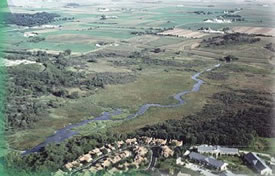Share:
OVERVIEW
Groundwater is an increasingly important resource for urban and rural potable water supply, irrigated agriculture, and industry, in addition to its natural environmental role of sustaining river flows and aquatic ecosystems. But major changes in land use that impact groundwater are taking place, as a consequence of population growth, increasing and changing food demands, and expanding biofuel cultivation. The link between land use and groundwater has long been recognized but has not been widely translated into integrated policies and practices. Sharply focused land-use management measures can produce significant groundwater quality and quantity benefits at relatively modest cost and improving integrated governance will be crucial to ensuring an acceptable harvest of both food and groundwater from the available land.
Land-use planning and development decisions must routinely take into account such factors as the location, quality, yield, vulnerability, and recharge potential of aquifers and the projected availability of water for the long term. To be truly effective, this information must be incorporated into local comprehensive plans and policies. Fortunately, there is a growing body of land-use tools that provide effective ways to protect groundwater and the environment, as a whole, and to maintain and improve our quality of life. But it is essential that local decision makers have access to these tools and that they apply them to land-use planning, zoning, and land acquisition decisions. When they do this, they can effectively protect and sustain their local groundwater resources.

WHY LAND USE MATTERS TO GROUNDWATER
Land-use management measures can produce significant groundwater quality and quantity benefits at relatively modest cost and improving integrated governance will be crucial to ensuring an acceptable harvest of both food and groundwater from the available land. Each time the use of a land area changes, it can affect the hydrologic makeup of the landscape. Highways, shopping centers, housing developments, industrial sites, businesses, agricultural operations, golf courses, feedlots, waste disposal sites, airports, ski slopes, and sewer systems (to name a few) have the potential to directly or indirectly impact the quantity or quality of both groundwater and surface water.
From the Ground Water Report to the Nation
Land Use – Summary Sheet : Full Chapter